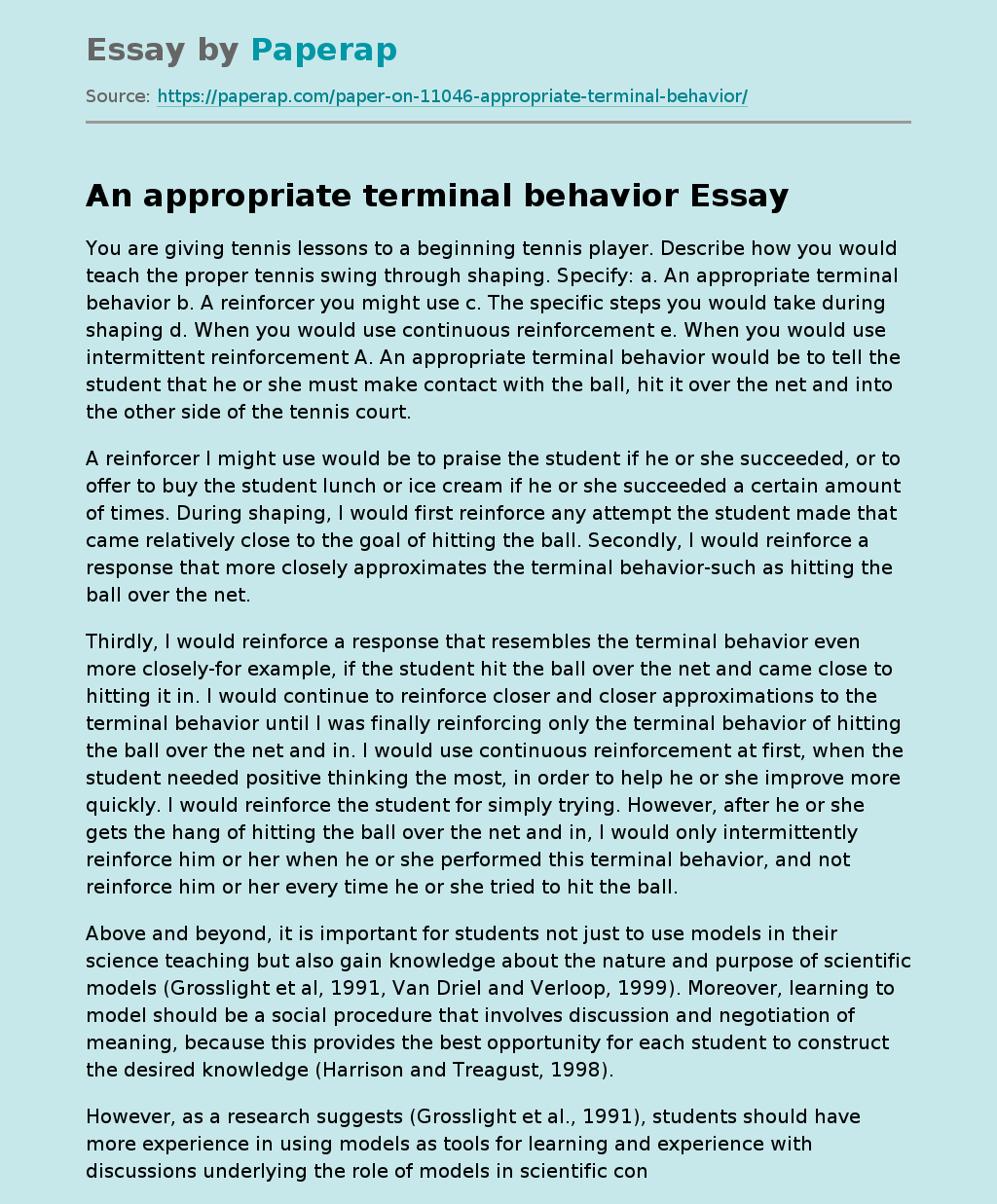An appropriate terminal behavior
You are giving tennis lessons to a beginning tennis player. Describe how you would teach the proper tennis swing through shaping. Specify: a. An appropriate terminal behavior b. A reinforcer you might use c. The specific steps you would take during shaping d. When you would use continuous reinforcement e. When you would use intermittent reinforcement A. An appropriate terminal behavior would be to tell the student that he or she must make contact with the ball, hit it over the net and into the other side of the tennis court.
A reinforcer I might use would be to praise the student if he or she succeeded, or to offer to buy the student lunch or ice cream if he or she succeeded a certain amount of times. During shaping, I would first reinforce any attempt the student made that came relatively close to the goal of hitting the ball. Secondly, I would reinforce a response that more closely approximates the terminal behavior-such as hitting the ball over the net.
Thirdly, I would reinforce a response that resembles the terminal behavior even more closely-for example, if the student hit the ball over the net and came close to hitting it in. I would continue to reinforce closer and closer approximations to the terminal behavior until I was finally reinforcing only the terminal behavior of hitting the ball over the net and in. I would use continuous reinforcement at first, when the student needed positive thinking the most, in order to help he or she improve more quickly.
I would reinforce the student for simply trying. However, after he or she gets the hang of hitting the ball over the net and in, I would only intermittently reinforce him or her when he or she performed this terminal behavior, and not reinforce him or her every time he or she tried to hit the ball.
Above and beyond, it is important for students not just to use models in their science teaching but also gain knowledge about the nature and purpose of scientific models (Grosslight et al, 1991, Van Driel and Verloop, 1999). Moreover, learning to model should be a social procedure that involves discussion and negotiation of meaning, because this provides the best opportunity for each student to construct the desired knowledge (Harrison and Treagust, 1998).
However, as a research suggests (Grosslight et al., 1991), students should have more experience in using models as tools for learning and experience with discussions underlying the role of models in scientific concepts. Wilensky and Reisman (2006) highlight the need for further experience with models in science education by saying that all students seek to understand science and the world around them. Besides, when students manage to accomplish modeling skills they can use them in novel situations in the domain of instruction (White, 1993, White and Frederiksen, 1990).
The use of models in science education requires great effort and there are difficulties that not only students but also teachers need to overcome, in order to achieve meaningful and efficient use of modeling. Teaching students about models and modeling has proven a quite challenging and difficult task (Schwartz & White, 2005). However, research showed that neither students nor their teachers possess efficient knowledge about the nature and purpose of scientific models (Van Driel &Verloop, 1999).
Consequently, some students fail to understand the purpose of engaging with the modeling process (Barrowy & Roberts, 1999) and they also might not realize the nature of models or modeling, even if they are engaged in creating and revising models (Carey and Smith, 1993; Grosslight et al., 1991). On the other hand research has shown (Louca & Constantinou, 2002) that learning about models and modeling can be accomplished in early middle school ages by guiding students through a process of developing and refining models about natural phenomena. Therefore teacher’s role in teaching science through an efficient and successful modeling approach is important.
Teachers should develop their knowledge in teaching scientific concepts and achieve self-efficacy in teaching and as Bandura (1981) argues self-efficacy can be enhanced through modeling. Similarly, Enochs et al. (1995) support that in order for elementary teachers to achieve self-confidence, well planned and modeled based lessons are required. Also, when students are building models and using their own analogies, instead of those of teachers, will be more benefited (Harrison and Treagust, 1998) and this is due to the fact that students’ analogies are more familiar and easier to understand (Zook, 1991).
On the other hand, students find it difficult to select appropriate analogies, so they expect from the teacher to give an analogy or a model, even if they have difficulties in mapping it (Harrison and Treagust, 1998). Moreover, some difficulties that students find when trying to construct meaning in science are due to the fact that they don’t have efficient ability and knowledge in developing conceptual models of physical phenomena (Golin, 1997). Consequently, teachers should use analogies and models in their teaching through an approach that involves focus, action and reflection (Treagust et al., 1998).
Also, considering the importance of hand-on lessons, primary teachers should continuously improve their teaching methods especially in the area of hands-on activity planning (Dickinson et al, 1997). Modeling teaching practices can be an appropriate and useful tool, since they promote teaching though practical demonstrations (Hudson, No date). Though, some times models that are used in physics only demonstrate the end product of physics to students (Steinberg, 2000), something that can limit students critical thinking and take from them the opportunity to observe and find out new phenomena by themselves.
An appropriate terminal behavior. (2017, Dec 20). Retrieved from https://paperap.com/paper-on-11046-appropriate-terminal-behavior/

